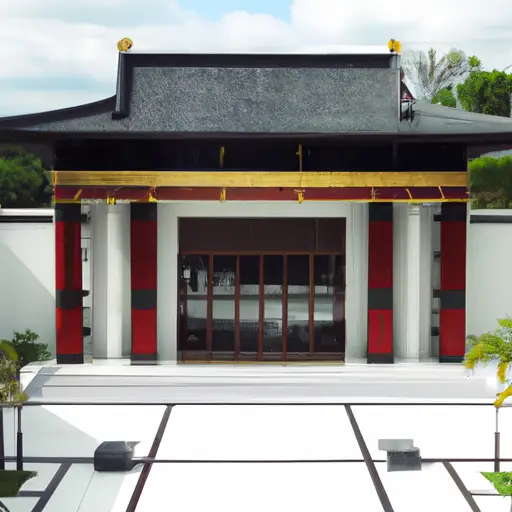Museo Nacional de Arte Oriental, Buenos Aires : Interesting Facts, Information & Travel Guide

- By
- Aparna Patel
- |
- 21 Jun, 2023
- |

If you are a lover of oriental art, then make sure you make it to Buenos Aires to visit the Museo Nacional de Arte Oriental. Located in the city’s newest suburb of Villa Urquiza, this museum is home to a large collection of traditional Asian artifacts, exhibits, and sculptures. In addition to the fascinating art and artifacts on display, this museum is also renowned for its stunning architecture and unique setting. Read on for an insider’s guide to this amazing space, including interesting facts, information, and travel tips.
Table of Contents
Interesting Facts About Museo Nacional de Arte Oriental, Buenos Aires
, Argentina
1. The museum was founded in 1912 to house a collection of Chinese and Japanese art, artifacts, and other cultural materials.
2. Since its opening, the museum has grown to include collections of Indian and Islamic art, as well as art and artifacts from countries around the world.
3. In addition to permanent collection galleries, the museum also hosts a variety of temporary exhibitions.
4. In 2017, the museum opened The Golden Hall in order to showcase its collection of Chinese art.
5. The museum also has an extensive library of Oriental culture and history books available to researchers.
6. The museum is open to the public from Tuesday to Sunday.
7. Visiting the museum is free of charge.
8. There is a cafe located in the museum and a souvenir shop can be found in the courtyard.
9. In addition, the museum also houses an auditorium, where a variety of events such as lectures, conferences and film screenings are held.
10. The museum collaborates with various associations and institutions in Argentina and abroad to preserve the cultural heritage of the Oriental world.
History & Information About Museo Nacional de Arte Oriental, Buenos Aires
Museo Nacional de Arte Oriental (National Museum of Oriental Art) is a museum in Buenos Aires, Argentina dedicated to the preservation, research and promotion of traditional Asian art. It is the only museum of its kind in Argentina and Latin America, housing a wide range of artifacts from countries such as China, India, Japan, Korea and other East and South-East Asian countries.
The museum was founded in 1960 with the support of the Argentine branch of the Asia Society. The museum has an extensive collection of artworks from all over Asia, such as statues, carvings, scrolls and screens, sculptures, funeral objects and traditional masks. The museum also houses a library with over 4,000 volumes related to Asian Art, culture and historiography.
In addition, the institution organizes educational programs, courses and workshops related to different aspects of the Asian Art tradition, such as calligraphy, painting and traditional Tea Ceremonies. It also organizes exhibitions, screenings, and concerts, as well as guided tours in a variety of languages, including English and Spanish.
The museum is open Tuesday through Sunday, from 10am to 5pm. Admission is free for all visitors.
- Casa de Gobierno de la Provincia de Buenos Aires, La Plata : Interesting Facts, Information & Travel Guide
- La Manzana de las Luces, Buenos Aires : Interesting Facts, Information & Travel Guide
- San Luis del Palmar : Interesting Facts, Famous Monuments & Information
Travel Guide For Visiting Museo Nacional de Arte Oriental, Buenos Aires
1. Getting to the Museum:
The Museum is located in the Palermo neighborhood in downtown Buenos Aires. The easiest way to get there is to take Buenos Aires’ public transit system, Subte. Take Line D to station “Plaza Italia”. From there, simply walk 10 minutes south on Estomba St. to get to the museum.
2. Hours of Operation:
The museum is open Tuesday through Sunday from 11:30am-7:30pm. It is closed on Mondays.
3. Cost of Admission:
Admission to the museum is free. However, there may be additional costs for special exhibitions.
4. What to See:
The museum houses a large collection of pieces from the Orient, including armor, paintings, textiles, and sculptures. There is a special section devoted to Japanese art, including a replica of a traditional Japanese house. There is also a plethora of artifacts from China, Korea, India, Vietnam, Thailand, and the Philippines.
5. Additional Tips:
Be sure to check the museum’s official website before your visit for any closures or special events. Photography is allowed in the museum, however there may be a small fee applicable.
- Basílica de San Francisco, Salta : Interesting Facts, Information & Travel Guide
- Casa de la Independencia, Tucumán : Interesting Facts, Information & Travel Guide
- La Bombonera Stadium, Buenos Aires : Interesting Facts, Information & Travel Guide
Frequently Asked Questions About Museo Nacional de Arte Oriental, Buenos Aires
Q1. What kind of art is featured at the Museo Nacional de Arte Oriental, Buenos Aires?
A1. The Museo Nacional de Arte Oriental, Buenos Aires is dedicated to Oriental art. Its collection includes important works of Chinese, Japanese and Korean art, as well as pieces from other Asian and Pacific regions.
Q2. How often does the museum host special exhibitions?
A2. The museum hosts several special exhibitions every year, ranging from traditional pieces to modern Asian art.
Q3. How can I learn more about the collections in the museum?
A3. The museum regularly publishes informational materials, including booklets, brochures and other multimedia tools that provide visitors with further information about the museum’s collections. Additionally, its website includes detailed information about individual pieces and the museum’s exhibitions.
Q4. Is there an admission fee to enter the museum?
A4. The admission fee to enter the museum is $2.
Search Posts
Latest posts
Popular posts
-
5 Mar, 2024
Why prohibit engine braking?
-
5 Mar, 2024
How to avoid drinking vodka?